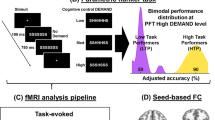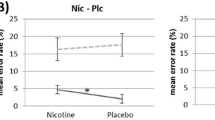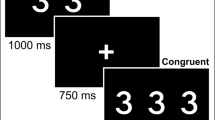Abstract
Rationale
Smokers report enhanced concentration after cigarette smoking and difficulty concentrating when abstinent from smoking. These perceived effects may contribute to smoking cessation failures, and if so, clarification of their cognitive bases could inform treatment strategies. Selective attention may be important in this regard, but earlier literature presents inconsistent findings on how smoking abstinence and resumption of smoking influence this cognitive function.
Objectives
We aimed to compare smokers and nonsmokers on selective attention, and in smokers, to test the effects of overnight abstinence from smoking and of acute smoking on selective attention.
Materials and methods
Smokers and nonsmokers (n = 43) performed a Stroop test (two test days, two test blocks per day). Smokers participated after overnight abstinence and also within 1-h of ad libitum smoking. Smokers each smoked a cigarette between test blocks on each day; nonsmokers did not.
Results
Smokers demonstrated longer response latencies for both congruent and incongruent stimuli after overnight than brief abstinence, but no deficit specifically related to selective attention. Whereas nonsmokers showed no changes in performance in the second test block, smoking between blocks reduced the Stroop effect when smokers were abstinent overnight.
Conclusions
These data are consistent with the hypothesis that abstinence from smoking among nicotine-dependent individuals has deleterious effects on cognitive performance, but do not indicate that selective attention is adversely effected. Improvement in selective attention after terminating abstinence with one cigarette may also contribute to smokers’ perceived enhanced ability to concentrate after smoking.

Similar content being viewed by others
References
American Psychiatric Association (1994) Diagnostic and statistical manual of mental disorders-fourth edition (DSM-IV). American Psychiatric Association, Washington, DC
Baldinger B, Hasenfratz M, Battig K (1995) Comparison of the effects of nicotine on a fixed rate and a subject-paced version of the rapid information processing task. Psychopharmacology (Berl) 121:396–400
Banich MT, Milham MP, Atchley RA, Cohen NJ, Webb A, Wszalek T, Kramer AF, Liang Z, Barad V, Gullett D, Shah C, Brown C (2000) Prefrontal regions play a predominant role in imposing an attentional ‘set’: evidence from fMRI. Cogn Brain Res 10:1–9
Bench CJ, Frith CD, Grasby PM, Friston KJ, Paulesu E, Frackowiak RS, Dolan RJ (1993) Investigations of the functional anatomy of attention using the Stroop test. Neuropsychologia 31:907–922
Brody AL, Mandelkern MA, London ED, Olmstead RE, Farahi J, Scheibal D, Jou J, Allen V, Tiongson E, Chefer SI, Koren AO, Mukhin AG (2006) Cigarette smoking saturates brain alpha 4 beta 2 nicotinic acetylcholine receptors. Arch Gen Psychiatry 63:907–915
Brown GG, Kindermann SS, Siegle GJ, Granholm E, Wong EC, Buxton RB (1999). Brain activation and pupil response during covert performance of the Stroop Color Word task. J Int Neuropsychol Soc 5:308–319
Carter CS, Mintun MA, Cohen JD (1995) Interference and facilitation effects during selective attention: an H2 15O PET study of Stroop task performance. Neuroimage 2:264–272
Cepeda-Benito A, Tiffany ST (1996) The use of a dual-task procedure for the assessment of cognitive effort associated with cigarette craving. Psychopharmacology (Berl) 127:155–163
Duncan E, Madonick S, Chakravorty S, Parwani A, Szilagyi S, Efferen T, Gonzenbach S, Angrist B, Rotrosen J (2001) Effects of smoking on acoustic startle and prepulse inhibition in humans. Psychopharmacology (Berl) 156:266–272
Evins AE, Deckersbach T, Cather C, Freudenreich O, Culhane MA, Henderson DC, Green MF, Schoenfeld DA, Rigotti NA, Goff DC (2005) Independent effects of tobacco abstinence and bupropion on cognitive function in schizophrenia. J Clin Psychiatry 66:1184–1190
George TP, Vessicchio JC, Termine A, Sahady DM, Head CA, Pepper WT, Kosten TR, Wexler BE (2002) Effects of smoking abstinence on visuospatial working memory function in schizophrenia. Neuropsychopharmacology 26:75–85
Gourlay SG, Benowitz NL (1997) Arteriovenous differences in plasma concentration of nicotine and catecholamines and related cardiovascular effects after smoking, nicotine nasal spray, and intravenous nicotine. Clin Pharmacol Ther 62:453–463
Gross J, Lee J, Stitzer ML (1997) Nicotine-containing versus de-nicotinized cigarettes: effects on craving and withdrawal. Pharmacol Biochem Behav 57:159–165
Gruber SA, Rogowska J, Holcomb P, Soraci S, Yurgelun-Todd D (2002) Stroop performance in normal control subjects: an fMRI study. Neuroimage 16:349–360
Hatsukami DK, Hughes JR, Pickens RW, Svikis D (1984) Tobacco withdrawal symptoms: an experimental analysis. Psychopharmacology (Berl) 84:231–236
Heatherton TF, Kozlowski LT, Frecker RC, Fägerström KO (1991) The Fägerström test for nicotine dependence: a revision of the Fägerström tolerance questionnaire. Br J Addict 86:1119–1127
Heishman SJ (1998) What aspects of human performance are truly enhanced by nicotine? Addiction 93:317–320
Hughes JR, Hatsukami D (1986) Signs and symptoms of tobacco withdrawal. Arch Gen Psychiatry 43:289–294
Hughes JR, Hatsukami DK, Pickens RW, Krahn D, Malin S, Luknic A (1984) Effect of nicotine on the tobacco withdrawal syndrome. Psychopharmacology (Berl) 83:82–87
Hughes JR, Keenan RM, Yellin A (1989) Effect of tobacco withdrawal on sustained attention. Addict Behav 14:577–580
Hughes JR, Higgins ST, Hatsukami DK (1990) Effects of abstinence from tobacco: a critical review. In: Kozlowski LT, Annis HM, Cappell HD, Glaser FB, Goodstadt MS, Israel Y, Kalant H, Sellers EM, Vingilis ER (Eds) Research advances in alcohol and drug problems, vol. 10. Plenum Press, New York, pp 317–398
Ilan AB, Polich J (2001) Tobacco smoking and event-related brain potentials in a Stroop task. Int J Psychophysiol 40:109–118
Jarvik ME, Madsen DC, Olmstead RE, Iwamoto-Schaap PN, Elins JL, Benowitz NL (2000) Nicotine blood levels and subjective craving for cigarettes. Pharmacol Biochem Behav 66:553–558
Johnsen BH, Thayer JF, Laberg JC, Asbjornsen AE (1997) Attentional bias in active smokers, abstinent smokers, and nonsmokers. Addict Behav 22:813–817
Madden CJ, Zwaan RA (2001) The impact of smoking urges on working memory performance. Exp Clin Psychopharmacol 9:418–424
Mancuso G, Warburton DM, Melen M, Sherwood N, Tirelli E (1999) Selective effects of nicotine on attentional processes. Psychopharmacology (Berl) 146:199–204
Mead LA, Mayer AR, Bobholz JA, Woodley SJ, Cunningham JM, Hammeke TA, Rao SM (2002) Neural basis of the Stroop interference task: response competition or selective attention? J Int Neuropsychol Soc 8:735–742
Milham MP, Banich MT (2005) Anterior cingulate cortex: an fMRI analysis of conflict specificity and functional differentiation. Hum Brain Mapp 25:328–335
Mogg K, Bradley BP (2002) Selective processing of smoking-related cues in smokers: manipulation of deprivation level and comparison of three measures of processing bias. J Psychopharmacol 16:385–392
Paradiso KG, Steinbach JH (2003) Nicotine is highly effective at producing desensitization of rat alpha4beta2 neuronal nicotinic receptors. J Physiol 553:857–871
Pardo JV, Pardo PJ, Janer KW, Raichle ME (1990) The anterior cingulate cortex mediates processing selection in the Stroop attentional conflict paradigm. Proc Natl Acad Sci U S A 87:256–259
Parrott AC, Craig D (1992) Cigarette smoking and nicotine gum (0, 2 and 4 mg): effects upon four visual attention tasks. Neuropsychobiology 25:34–43
Perpina C, Hemsley D, Treasure J, de Silva P (1993) Is the selective information processing of food and body words specific to patients with eating disorders? Int J Eat Disord 14:359–366
Pickworth WB, Fant RV, Nelson RA, Rohrer MS, Henningfield JE (1999) Pharmacodynamic effects of new de-nicotinized cigarettes. Nicotine Tob Res 1:357–364
Pomerleau CS, Teuscher F, Goeters S, Pomerleau OF (1994) Effects of nicotine abstinence and menstrual phase on task performance. Addict Behav 19:357–362
Provost SC, Woodward R (1991) Effects of nicotine gum on repeated administration of the Stroop test. Psychopharmacology (Berl) 104:536–540
Robinson ML, Houtsmuller EJ, Moolchan ET, Pickworth WB (2000) Placebo cigarettes in smoking research. Exp Clin Psychopharmacol 8:326–332
Rose JE (2005) Nicotine and nonnicotine factors in cigarette addiction. Psychopharmacology (Berl) 1–12
Rukstalis M, Jepson C, Patterson F, Lerman C (2005) Increases in hyperactive-impulsive symptoms predict relapse among smokers in nicotine replacement therapy. J Subst Abuse Treat 28:297–304
Russell MAH, Peto J, Patel VA (1974) The classification of smoking by a factorial structure of motives. J R Stat Soc 137:313–346
Rusted JM, Caulfield D, King L, Goode A (2000) Moving out of the laboratory: does nicotine improve everyday attention? Behav Pharmacol 11:621–629
Sacco KA, Termine A, Seyal A, Dudas MM, Vessicchio JC, Krishnan-Sarin S, Jatlow PI, Wexler BE, George TP (2005) Effects of cigarette smoking on spatial working memory and attentional deficits in schizophrenia: involvement of nicotinic receptor mechanisms. Arch Gen Psychiatry 62:649–659
Sayette MA, Hufford MR (1994) Effects of cue exposure and deprivation on cognitive resources in smokers. J Abnorm Psychology 103:812–818
Shiffman SM, Jarvik ME (1976) Smoking withdrawal symptoms in two weeks of abstinence. Psychopharmacology (Berl) 50:35–39
Stormark KM, Laberg JC, Nordby H, Hugdahl K (2000) Alcoholics’ selective attention to alcohol stimuli: automated processing? J Stud Alcohol 61:18–23
Stroop JR (1935) Studies of interference in serial verbal reactions. J Exp Psychol 18:643–662
Taylor SF, Kornblum S, Lauber EJ, Minoshima S, Koeppe RA (1997) Isolation of specific interference processing in the Stroop task: PET activation studies. Neuroimage 6:81–92
Warburton DM, Wesnes K (1984) Mechanisms for habitual substance use: food, alcohol, and cigarettes. In: Gale A, Edwards J (eds) Physiological correlates of human behavior, vol 1.: basic issues. Academic, London pp 277–297
Ward MF, Wender PH, Reimherr FW (1993) The Wender Utah rating scale: an aid in the retrospective diagnosis of childhood attention deficit hyperactivity disorder. Am J Psychiatry 150:885–890
Wesnes KA, Warburton DM (1978) The effects of cigarette smoking and nicotine tablets upon human attention. In: Thorton RE (ed) Smoking behaviour: physiological and psychological influences. Churchill-Livingston, London, pp 131–147
West RJ, Jarvis MJ, Russell MA, Carruthers ME, Feyerabend C (1984) Effect of nicotine replacement on the cigarette withdrawal syndrome. Br J Addict 79:215–219
West RJ, Hajek P, Belcher M (1987) Time course of cigarette withdrawal symptoms during four weeks of treatment with nicotine chewing gum. Addict Behav 12:199–203
Westman EC, Behm FM, Rose JE (1996) Dissociating the nicotine and airway sensory effects of smoking. Pharmacol Biochem Behav 53:309–315
World Health Organization (2003) World Health Report 2003. Available at http://www.who.int/whr/2003/en/overview_en.pdf
Xu X, Domino EF (2000) Effects of tobacco smoking on topographic EEG and Stroop test in smoking deprived smokers. Prog Neuropsychopharmacol Biol Psychiatry 24:535–546
Zack M, Belsito L, Scher R, Eissenberg T, Corrigall WA (2001) Effects of abstinence and smoking on information processing in adolescent smokers. Psychopharmacology (Berl) 153:249–257
Zwaan RA, Stanfield RA, Madden CJ (2000) How persistent is the effect of smoking urges on cognitive performance? Exp Clin Psychopharmacol 8:518–523
Acknowledgements
Supported by NIH grants RO1 DA014093.03 (EDL), RO1 DA015059 (ALB), and MOIRR 00865; UC Tobacco-Related Disease Research Program awards 10RT-0091 (EDL) and 11RT-0024 (ALB), a VA Merit Review Type I Award (ALB), and Philip Morris USA and Philip Morris International (EDL). Experiments comply with the current laws of the United States.
Author information
Authors and Affiliations
Corresponding author
Rights and permissions
About this article
Cite this article
Domier, C.P., Monterosso, J.R., Brody, A.L. et al. Effects of cigarette smoking and abstinence on stroop task performance. Psychopharmacology 195, 1–9 (2007). https://doi.org/10.1007/s00213-007-0869-x
Received:
Accepted:
Published:
Issue Date:
DOI: https://doi.org/10.1007/s00213-007-0869-x




